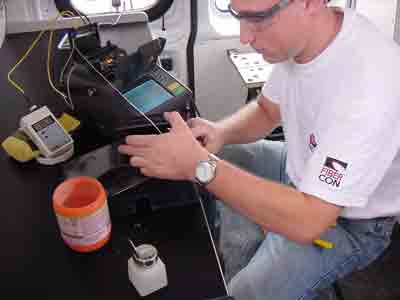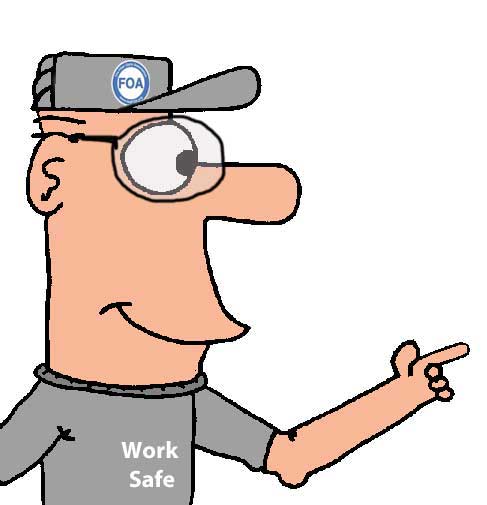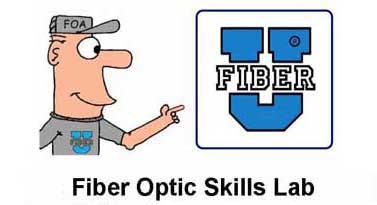Lesson
1: Introduction, Fiber Optic Safety
Objectives:
From this lesson you should learn:
What will be involved in learning the skills necessary to
install fiber optics
Guidelines for setting up a lab or work area
How to proceed with this self-study program
How to work with fiber safely
Introduction
This Fiber U course is designed help you learn how to
prepare cables for termination or splicing, then
terminate, splice and test them. To get the most out of
this course, the “hands-on” exercises, you should have
some knowledge of fiber optics or have completed the
Fiber U
Basic course already, so you know the “jargon” and
all about the basics of fiber optics.
Begin by reviewing the lesson plans in the following
pages. It will give you an overview of what you will be
doing in each section and help you organize your work. You
will want to follow the same procedure with each section:
1) watch and/or read the reference material, 2) set up
your equipment for the lab and 3) do the hands-on
exercises.
Make certain
before you begin that you have everything you need -
tools, test equipment and components. Refer to the check
list on Lesson 2.
It helps to watch the videos completely at least once. You
will probably find it convenient to have them ready to
play while you are doing the hands-on exercises or you can
use the VHO (Virtual Hands-On) links. They will show you
step-by-step how to do the exercises using the processes
we have gotten from manufacturers and instructors as well
as have developed in our own labs. It is very important to
follow the steps in order to properly complete the
exercises.
Work in a space where you will not be disturbed and avoid
distractions. It is important you concentrate on the
exercises and follow each step carefully.
Allow plenty of time to complete the exercises without
interruption, especially termination. During the
termination exercise, you will use adhesives which must be
used quickly.

This splicer has his
safety glasses on, is working on a black mat to help see
the fibers and has a trash bin handy.
Safety
 |
Please
Note: This is not the usual online course
- it is intended to guide you as you learn
new skills - the skills needed to install
optical fiber cable plants. It involves
using tools and components in a realistic
manner. Some of the processes here can be
hazardous, like working with sharp scraps
of optical fiber and chemicals. The first
lesson is about safety - we recommend
reading it carefully and posting the
safety rules for everyone to see. Always
wear safety glasses when doing any of
these exercises and dispose of all scraps
properly.
|
These
guidelines are strictly the opinion of the FOA
provided for educational purposes and the reader
is expected to use them as a basis for learning.
The FOA assumes no liability for the use of any
of this material.
Familiarize yourself
with the safety procedures and follow them all the time.
Watch FOA
Lecture 2: Safety When Working With Fiber Optics
Do not work with fiber without safety glasses
and a proper work area that is easy to clean up. It
is recommended to not work on carpeted areas because fiber
scraps can become imbedded in the carpet and be difficult
to find and remove.
A pair of safety glasses must always be worn. Use
them, keep them clean, and protect them from damage like
any other tool. You must always wear safety glasses
because you will generate fiber scraps that may fly
through the air and land anywhere. If scraps get into your
eye, you will be making a visit to the local hospital
emergency room.

X-ray of fiber shard in finger
The broken or cleaved ends of fibers are extremely
sharp and can easily penetrate your skin! Be
careful to not stick the broken ends into your fingers,
since they invariably break off and are very hard to find
and remove. Most times, you have to wait for them to
infect and painfully work themselves out. A pair of
tweezers are included in the kit for removing splinters.
Carefully pull the glass splinters out before they have a
chance to break off and become lodged in the skin.
Avoid these painful accidents by exercising a little
caution. Dispose of all scraps properly. Keep a
piece of double stick tape on the bench to stick them to
or put them in a properly marked paper cup or other
container to dispose of later. Do not drop them on the
floor where they will stick in carpets or shoes and be
carried elsewhere. Do not eat anywhere near the work area.
We recommend working on a black table mat to make it
easier to see the fiber (and any scraps). It is
best to work on tile or concrete floors, not carpet. If
you drop fiber scraps into carpet they can be very hard
to find or pick up with a vacuum cleaner.
Clean up after your exercises carefully. Some of
the scrap you generate can be harmful, such as fiber ends,
so we recommend you not work anywhere near food
preparation or children’s play areas! Place clean paper
over your work area to keep from harming the worktable
surface.
Download
a FOA safety poster for your work area.
Assignment:
Watch the videos and/or read the references and take the
quiz.
Fiber U Basic Skills Workbook (Download)
YouTube Videos

FOA
Lecture 2: Safety When Working With Fiber Optics
Online FOA Guide:
Fiber
Optic Safety
Book Chapter:
FOA
Reference Guide to Fiber Optics, Chapter 1,
Section on Safety
Test
Your Comprehension - Online
Quiz On Safety
- Next: Lesson
2: Fiber Optic Tools, Test Equipment and
Supplies

Get a "Certificate
of Completion" When You Complete The Course
After you complete all 6 lessons of the Fiber U Basic Skills Lab
Fiber Optics online self-study course, you can
now take an online exam and, when you pass the
exam, get a "Certificate of Completion" for this
course. You should complete all lessons
including taking the quiz ("Test Your
Comprehension") at the end of every lesson. When
you think you are prepared, you can take an
online exam for a nominal fee ($20) which will
give you a "Certificate of Completion" for
this course.
Take the Test to Get Your
Certificate of Completion For This
Course
Return
to Lesson Plan
This information is
provided by The Fiber Optic Association, Inc. as a
benefit to those interested in teaching, designing,
manufacturing, selling, installing or using fiber optic
communications systems or networks. It is intended to be
used as an overview and/or basic guidelines and in no
way should be considered to be complete or
comprehensive. These guidelines are strictly the opinion
of the FOA and the reader is expected to use them as a
basis for learning, as a reference and for creating
their own documentation, project specifications, etc.
Those working with fiber optics in the classroom,
laboratory or field should follow all safety rules
carefully. The FOA assumes no liability for the use of
any of this material.
|

